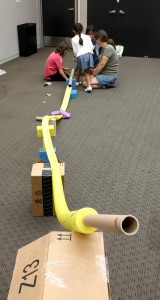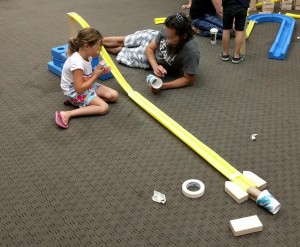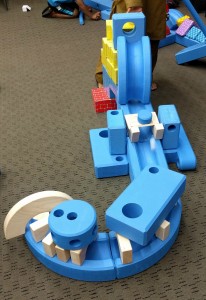We’ve been exploring all things architecture this summer in the BOOMbox, Skokie Public Library’s experiential learning STEAM space. I’ve mentioned a foray into preschool programming around the architecture theme in a previous post, and now I’m glad to share a challenge aimed at this school-age audience. We just hosted our second architecture-themed STEAM family challenge of the summer: it’s a one-hour program for youth in kindergarten through 5th grade with their adult caregiver called Mission: BOOMbox. This program’s challenge was to design, build, and test the ultimate indoor roller coaster using a combination of various building materials and balls of different sizes and weights.
We hosted this program in a larger multipurpose room in the library. All tables and chairs were cleared so there was plenty of building space on the floor throughout the room to accommodate participants and their creations. Pro tip: consider having chairs and tables readily available nearby should they be needed for accessibility. I placed each type of building material at various points along the room’s perimeter, presenting a sort of visual inventory of the available supplies. Materials were pulled from other programs and throughout the library and included assorted cardboard boxes; pool noodles cut in half lengthwise; newspapers; KEVA Planks; Imagination Playground blocks; assorted wooden blocks; and assorted foam blocks. I used a book cart to make tape, marbles, and balls of different sizes accessible for participants to use.
As people arrived, I encouraged them to look around the room at the different building resources and think about the design of their roller coaster and which supplies would be best to build with. At the start of the program, I introduced myself and the BOOMbox theme. I then asked what participants knew about architects and architecture, and what concepts or skills were involved. Many replied that architects designed buildings and that they needed to be good in math and drawing. From here, I bridged to the program’s challenge, explaining that participants would work together in groups or as families to design, construct, and test indoor roller coasters for marbles or other balls to ride. They were given 30 minutes to build (extended to 33!) and could only use the resources provided.
Youth and adults alike got to work right away, communicating with their teammates about what they wanted to build and how they would move forward. Adults asked great guiding questions and provided assistance without taking over construction from their children. I provided time reminders at various intervals during building to ensure everyone could keep on pace. I also walked around asked why teams chose certain materials, what balls would work best with certain designs, and for participants to tell me about their roller coaster.
After the build time, we gave everyone a round of applause. I then asked each group or family to share insights to the larger group about their building experience, what they found easy and what they found challenging, before showing off their roller coaster in action. Many groups described learning that some piece of their design didn’t work, so they went back to the drawing board and tried again with something new. They also used this go-around time as a photo opportunity, and the youth participants enjoyed showing off their designs to a larger group.
I love programs like this because they get families working together towards a common goal with the children leading the way. In this particular program, participants gained a better understanding of the many hats architects must wear in order to execute a successful design, be it a roller coaster, house, or skyscraper. This program can be adapted to be more concept-based by calculating the speed of the roller coaster after measuring its height and length or having participants draw and measure their designs before constructing. For a one-hour weekend program, however, the free building challenge and thrill of seeing marble coasters in action was just the thing.







Leave A Comment